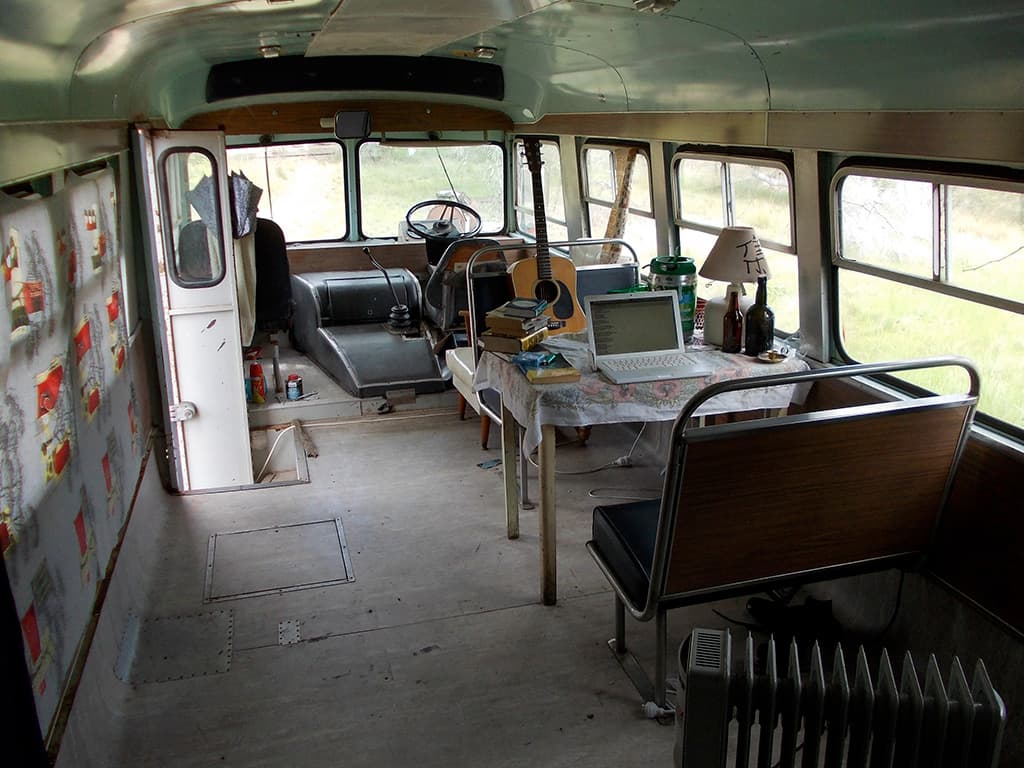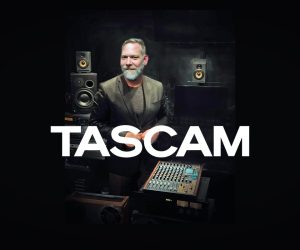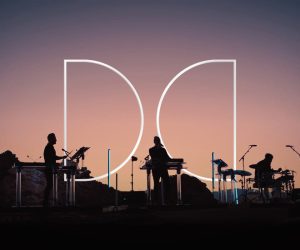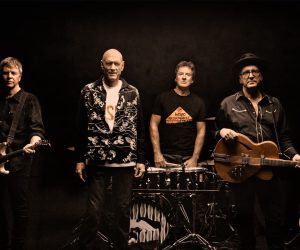
The Sound of a Car Crash
The Drones frontman Gareth Liddiard recorded I See Seaweed in a demountable classroom from the ’60s that he’d reno’ed for 10 grand. Then he turned it into a kitchen.
Gareth Liddiard lives up a dirt road “in the middle of f**king nowhere” where he recorded his band, The Drones’ latest album I See Seaweed in a renovated demountable classroom from the ’60s. He spent 10 grand on the classroom-come-studio conversion, and after just the one album, it’s already been turned into a kitchen and lounge for he and his partner/Drones bassist, Fiona Kitschin.
It’s illustrative of Liddiard’s fear of complacency that he would exert the effort to construct an entirely new studio, only to abandon the future possibility of recording there after a single album. Oddly though, place has played a significant part in their previous two full-length albums. 2008’s Havilah was named after the Victorian alpine valley it was recorded in, and 2006’s Gala Mill was made in a mill on Gala Farm, a 10,000-acre sprawl on Tasmania’s east coast. But the names seem more about putting it ‘on the record’ — a statement of origin rather than any kind of nostalgia. “We don’t really record anywhere twice,” said Liddiard. “It’s fun finding a different room and being surprised. It’s enough to be good at knowing mic and preamp combinations and amplifiers, I’m happy with knowing my way in and out of that shit, but the room is something I like to change.”
As for the demountable shell: “It’s big, 11 by nine metres, hardwood floor, the ceiling’s about 3.5m tall and there’s windows down both sides — a lot of glass and shiny surfaces. We renovated that up, and it was a lot of work… about three months. I was really worried it was going to sound like a basketball court. But we bought a bunch of cheap and nasty velvet curtains off eBay and threw a Persian rug or two in there and it ended up sounding really good.
“It was a big open space and we all went in there with the amps, or sometimes set them up outside under the house, or in a bedroom nearby. We would all sit in the room with cans around the drums, and most of the singing is live so it’s feeding into the drum mics and vice versa, otherwise it’s all isolated.”
KIT STUDIO
Given Liddiard’s nomadic recording patterns, he’s wisely decked himself out with some mobile recording gear… okay, maybe ‘mobile’ is an overstatement, let’s say shiftable. He’s had a few bits and pieces over time, but after wrapping Havilah, he started to build his collection of outboard, mics and recording gear [see sidebar] into quite a formidable setup, racked and ready to roll. As well as a strong collection of outboard preamps, he also has a collection of compressors, including JLM Audio LA500 opto compressors from kits. “I built a bunch of it from kit form, because I’m not loaded, and I’ve done it a million times,” said Liddiard. “I learned about electronics whilst touring Europe a lot and constantly having old, irreplaceable pedals f**k up. So I’ve always taken a soldering iron with me and fixed everything. It was all a part of making the album too; factor that into the six months and it was actually quite busy.” To help pay off his new collection, Liddiard hires the rig out to other bands making albums in non-studio locations, which means “it’s sort of paid for itself — a wonderful thing.”




KNOW THY BEYER
When you’re constantly setting up to record in new environments, Liddiard says the key is knowing your gear inside out so you can focus on mastering the space. “I’ve got about 20 mics and now I’m intimately knowledgeable about what they do, down to their impedances,” said Liddiard. “I know them as intimately as I know my amps and pedals now. So whether it’s a violin, or an amp that needs recording from six metres away, I’ll know what combo and pre will kill it. I’m a Beyer man. I’ve got a bunch of M201s. I’m fanatic about them. M88, M69, and I love the M160 ribbon mics because they have a hyper-cardioid pattern. Everyone always goes on about Coles 4038s, and all those classic ribbons. But they’re all figure of eight, so when you’re miking up a guitar cab you can never get it in phase. I find that so annoying. With the M160 it doesn’t matter. You just put the capsule near whatever mic you’re pairing it with, and it’s always good. It means you can move fast. They sound good, are the most chilled overheads, and the cheapest of all the ribbons — I don’t know why they’re not more popular.”
Liddiard describes the Beyerdynamic mics as austere — a no-nonsense character that complements the band’s wilder aesthetic. “The guitars sound harsh enough,” said Liddiard. “When it comes to recording it’s more a matter of toning them down. Say you had [Pink Floyd’s] David Gilmour, you could mic him up real harsh and get quite a technically harsh sound, but it would still sound cool and smooth. With us, you could technically try and smooth it out, but it would still sound harsh. It just translates. So if something sounds really nasty and thin, I use the mic that would fatten it up.”
Before setting any mics up though, Liddiard spends plenty of time walking the room and listening to it. “If an electric guitar, especially one of ours, tears your head off in a room, it’s probably time to deaden it down a bit,” he said. “For drums you can walk around with a floor tom banging it. You hear the bass traps and stay clear of them, and put it in the most neutral area.”
Liddiard has always been heavily involved in the process, and enjoyed having people around to learn from, but I See Seaweed was the first time The Drones didn’t hire an engineer for the sessions, leaving Liddiard to do all the heavy lifting. “I’m not an expert by a long shot, but I’m getting there,” said Liddiard. The definitions of a producer or engineer are getting looser these days, and Liddiard saw it as a group effort. All the members of The Drones have recorded countless times, so it’s not exactly a foreign concept to any of them. Previous collaborator Burke Reid came in to mix, and Liddiard’s neighbour,
Andrew McGhee, was often able to lend a helping hand. McGhee happens to run The Empty Room studio just a couple of klicks down the road where he’s recorded Spencer P Jones, Kim Salmon and plenty of other Aussie artists.
SOUND OF A CAR CRASH
Noise has always made up a big part of The Drones’ sound. There’s an art to good noise, which by nature doesn’t seem to stick to any rules, but Liddiard has a simple idea that makes simple sense.
“You can’t really invent a noise that the natural world hasn’t already invented,” said Liddiard. “The sound of cymbals is the sound of waves crashing. The sound of a drum beat is like a pulse or footsteps which could be meandering down the street or marching to war.
“Miles Davis said it really well, that as the 20th century moved along, the harsher elements of popular music like John Lee Hooker or Jimi Hendrix, they changed with the sound of car crashes. Early on car crashes were these screeching, tearing of metal sounds. A huge thwack, followed by a hubcap going dling, dling, dling along the ground. And then the later 20th century it was just the sound of crinkling alloy and plastic. And now it’s all computer sounds and glitches.
“You mimic. As long as the noise you’re making reflects what’s currently a noise that’s naturally out there, then I think it’s a valid noise.”
Mark Davie: Do you create noise purely as a musical release, or is it more constructed than that?
Gareth Liddiard: Bit of both really. There’s a release in it. It’s a modern sound and on Grey Leader Dan [Luscombe]’s got a pedal called a Noise Floor, and I’ve got a custom-made fuzz pedal I’ve modified — a huge, weird thing from a company called 4ms in The States — that has oscillators built into it. It’s a really organic, living, little thing.
MD: Do you wrestle with the balance between recording fidelity and what people expect of The Drones as a raw noise band?
GL: Maybe once upon a time I did. But you can’t really hide what we are. If I’m playing guitar and singing, it sounds like The Drones-ey thing. I feel a bit freer now. We can bury things in a wall of verb and wash them out completely. It can be very opaque, or dry as anything and it would still sound like us.
I built a bunch of it from kit form, because I’m not loaded, and I’ve done it a million times



VOCAL DYNAMICS
MD: Similarly to the guitars, your voice is quite dynamic. What mics work well for you?
GL: Over the years I’ve used heaps of stuff. Early on, transformer-less U87-type things work really well on me. A Rode Classic II worked spectacularly well on me, weirdly enough, because they’re quite toppy — the tube pickup is slow, so it helps smooth out what I do. But then some prick flogged it. I’ve had great success with an old Sennheiser MD421 — it worked wonders.
MD: Do you find it easier to work with a dynamic mic?
GL: I’m a guitar player, so my hands are on the guitar, but when I’m doing a vocal overdub I do feel better with a mic I can grab. And there’s something really disconnected about not being able to touch large diaphragm condensers. It’s not a natural way to sing. Singers spend their whole lives singing into dynamic mics, and then someone plonks a mic you can’t touch in front of you, and it f**ks with you. It’s like if I used a Jaguar [guitar], and then when I recorded I suddenly had to use a Les Paul — that’s awkward and weird.
MD: Are you a one guitar man then?
GL: I’ve got two hot-rodded Jaguars — on the inside they’re like a ’52 Les Paul.
MD: Do you like them because you use the whammy bar a lot?
GL: Yeah the whammy stuff, and I like the really skinny necks. The necks are also short, so they go ‘boing’ more than long-scale necks. And you can do all sorts of weird things with the strings behind the bridge. But I sounded too much like Roland Howard with the single coils they come with, so I stuck a PAF [pickup] in it. And now I sound like Neil Young. So I can’t win!
MD: Yeah, you really need to find your own sound…
GL: It’s too late. I’m 38.
KEY TO A NEW BEGINNING
MD: The main change on this album is you’ve got Steve Hesketh on keys full time. How did that come about?
GL: Well he’s done a bunch of stuff with us. Early on, he played on Way Long By The River and The Miller’s Daughter. He’s been a buddy for over 10 years. Usually Dan would play keys if we wanted keys. But we just thought it would be a good idea to have someone else in there to flesh things out. And we couldn’t play a lot of songs live because the way they’re arranged on record — we were short on people. It’s fun having him around because it’s been the four of us for years. It’s like siblings — you get tired of each other and you run out of things to say.
MD: These days it seems that if you’ve got a keys player in a band, they’ll play every sound under the sun. It’s different to hear primarily piano playing on a rock record.
GL: Yeah, it’s mostly piano and a little extra string pads and Hammond. A piano is just one of those instruments, one of the mainstays of the last 150 years. You can do anything with them. I listen to a lot of 20th century classical music when I’m doing the dishes, and I’ve always found the piano is the most engrossing thing because you can hear what they’re doing, rather than a huge orchestral arrangement. It’s laid bare. You can hear the scales, the techniques and the mind of the composer ticking over better. The ideas are clearer. Things are a bit simpler with a piano.
MD: How did you record it?
GL: It’s just Native Instruments’ Kontakt. A DI into a shitty old Allen & Heath desk from the ’70s to brown it up a bit. Technically it’s a piece of shit but you know those old sepia-filtered photos of cowboys? It does that to sound.
Years ago I read Andy Johns talking about his approach to a mix, and he literally said, ‘Just f**k with it until it sounds good’
THE DRUMS
Despite the guitars dominating much of the landscape on Drones records, Mike Noga’s drums certainly drive the dynamic forces. Songs can range from brushed tom work to an all-out up-tempo beating, and capturing that natural feel without losing power led Liddiard to some interesting mic placements.
“Having a drum kit essentially in your lounge room after the band’s gone home is good,” said Liddiard. “I just messed with it until I got it sounding big. So the mic setup is quite weird on this album.
“We used to have left/right overheads panned left/right, and then left and right guitars were panned left and right. But now, I’ve started to learn the stereo picture can be better achieved if you run one overhead through a chorus pedal and spread it even wider. For some reason the stereo image is more panoramic, and then you put everything inside that. Ultimately I end up turning the guitars up too loud so you can’t hear the kit anymore and that’s The Drones mix!
“I found the best way to mic a kick drum is to surround it. You put the classic Neumann U47 FET or whatever a couple of feet in front of the resonant skin. But around the other side — under the snare and about four inches from where the kick is hitting the batter head — I put a Neumann U87 about an inch from the skin, which gives massive bottom end. You mix the two together to taste (they’re both large diaphragm so they pick up a lot of ambience) and you get the fattest thing you’ve ever heard. You can even go too fat, which is a luxury I’ve never had before.
“Under the crash cymbal there’s a large diaphragm condenser, sitting evenly between the crash, rack tom and snare. And another one under the ride cymbal, sitting evenly between the ride cymbal and floor tom. Both are set to omni and pick everything up, which is kind of weird. Over the top, I spread two Beyer M160s wide. The M160s are hyper-cardioid, so they leave the biggest hole in the middle for your snare mic to punch through. It’s like a vacuum in the middle, and you can properly control your snare, whereas most times the snare bleeds into the overheads and you don’t get as much control. And then a mono overhead on top.
“Sometimes we’d simply use one mono overhead, a large diaphragm condenser underneath the snare, and then maybe one of the other large diaphragms under the cymbals, and that was it, with the room mics. And then we’d do things like run that mono overhead through a chorus, which came back in stereo.”
MESSING IT UP ’TIL IT’S RIGHT
GL: I don’t think we’ve ever had anything except a DI’d bass on a Drones record. Just DI’d into any old Neve, then maybe through a UREI 1176 compressor, and a bit of EQ. We usually leave it as is, and it seems just fine. The guitars are just in another room, and what we had on them changed. The Beyer M201s or Shure SM57s, next we had one of the Royer 121 ribbons, but it was annoying to get in phase.
“Then we had room mics, and all sorts of other weird shit, depending on the song. We’re not scared of doing anything weird. We often DI guitar and mix it with a re-amped signal — whatever works.
“Years ago I read Andy Johns talking about his approach to a mix, and he literally said, ‘Just f**k with it until it sounds good.’ And that’s what you do. It’s an empirical thing. If you’ve done it a million times, you’ll just get quicker at finding where it sounds good. Otherwise it might take a while. But whoop-di-do… it takes time. It’s just a process of doing it until it sounds good.
















RESPONSES